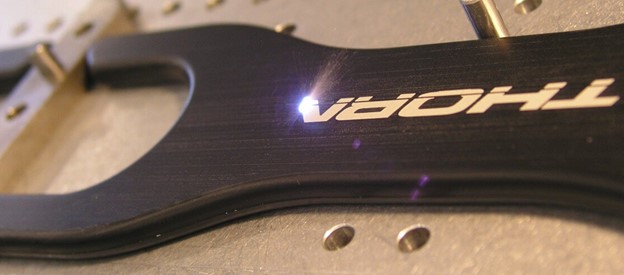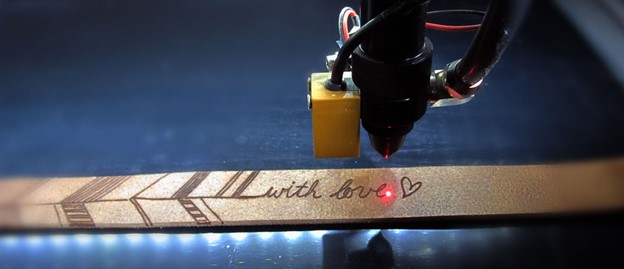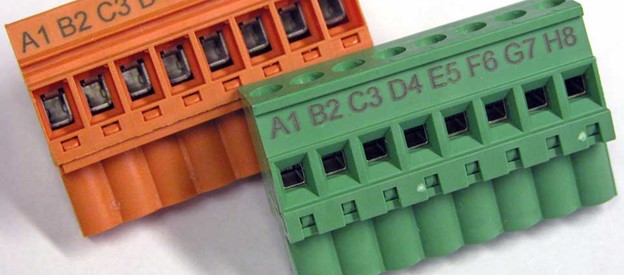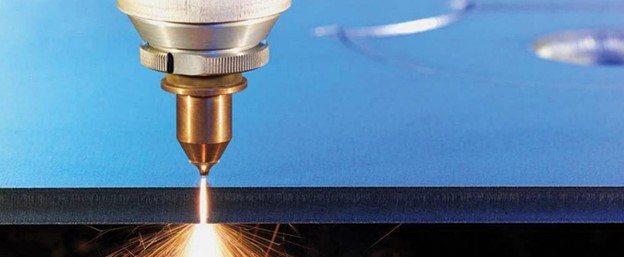Laser engraving is the most popular laser marking technology in product identification and traceability. It involves using a laser marking machine to make permanent markings on different materials. Laser engraving technology is highly accurate. Consequently, it is the go-to option for marking parts and products in many industries, especially automotive and aeronautics.
This article explains everything you need to know about the technology before incorporating it into your project.
What Is Laser Engraving?

The process involves using a laser marking machine which we will call a laser engraving machine, to vaporize specific areas on almost any material. Consequently, it forms permanent markings with higher contrast than the unmarked regions on the part or product.
The process is suitable for marking logos, barcodes, serial numbers, and QR codes on parts. Alongside laser etching, annealing, ablation, and other laser marking technologies, the process forms a set of highly reliable processes in traceability, identification, and product decoration.
Brief History of Laser Engraving
Laser engraving’s history cannot begin without talking about manual engraving. Manual engraving is a process that involves using a sharp object (engraving tool) to inscribe a marking on the part. For example, stones were engraving tools about 500,000 years ago. Currently, the oldest manually engraved part dates to about 500,000 years ago.
Manual engraving evolved over the years due to technological advancement. The beginning of the laser engraving process would be premised on Albert Einstein’s idea of LASER 1916 and its optimization in the 1950s.
Theodore Maiman created the first optical laser. Gordon Gould would be credited with making the original laser light.
Laser became an important part of drilling when Western Electrics made the first laser machine in 1965. However, its real use in engraving wouldn’t be until the advent of CO2 lasers in 1967. Further technological advancement has led to the development of other types of machines applicable in engravings, such as UV and MOPA laser markers.
How Does Laser Engraving Work?

Laser engraving involves focusing a laser beam on a part from a distance at a suitable power level. This vaporizes the material leaving a permanent marking on the parts. Adjusting the power is important as too little will be ineffective, and too much will burn the material.
The laser engraving process is very straightforward. Below are the steps you need to take to laser engrave a part:
· Ideation
Ideation is the creation of ideas on how the markings will look and the right materials for the job. It requires high creativity. Therefore, it is the most important step of the laser engraving process as it determines the quality of the markings and their efficiency.
Ideation is also very important because laser engraved markings are permanent. As a result, it is not easy to change wrong markings after completing the marking process.
· Design the Image for the Marking
Design the image you want to mark on a computer program. You can use Adobe Illustrators, Inkscape, Lightburn, DraftSight, and Onshape to create graphic designs. Also, you need to ensure the machine is compatible with the designed file.
· Choose the Material
Choose a material that is compatible with the laser engraver and complements your design. Generally, laser engraving machines work with materials such as stone, glass, plastics, and metals. However, each type is suitable for a secluded list of materials. For example, UV laser markers are suitable for plastics since they don’t produce high heat (they are cold lasers), while CO2 laser markers are suitable for organic materials.
- Set up the Machine
The settings and types of engraving machines separate its process from each other. Set the laser strength, cut depth, speed, number of passes, and line thickness, and test similar test materials to see their effects. Store the best settings that reflect what you want
· Laser Engraves the Part
Place the material in the machine and mark it. You can remove the material from the machine and clean it on marking.
Materials Used for Laser Engraving Process
The laser engraving process is compatible with many materials. Below are a few ones you can consider for your project.
Plastics

Plastics such as acrylic and POM are common laser engraved materials. However, the power of the laser must be adequately regulated and tailored to the materials absorption spectrum and other present additives. Plastics are more compatible with CO2 and UV laser markers.
Metals

Metals are the most common materials people laser engraved hence the term “the heart of many industries.” Examples of metals compatible with the process are stainless steel, gold, silver, iron, and aluminum. Fiber engraving machines are the most suitable marking machines for metals.
Woods

Woods are also compatible with the process. Many people consider them a fire hazard due to the high heat. However, you can tune the laser marker’s power to make it possible to engrave wood without catching fire. Plywood, MDF, and cardboard are popular wood materials you can engrave with machines.
Coated Metals
The process is also suitable for coated metals, being applicable in vaporizing the metal’s coating. This leads to the clean removal of the coating.
Advantages and Disadvantages of Laser Engraving

Laser engraving is highly recognized industry-wise due to its advantages, such as fast production speed, precision, and capability with various materials. However, the process also has its disadvantages. Below are a few advantages and disadvantages you should take note of.
Its Advantages
– Speedy production process
It is a fast process that can take between 3 to 5 minutes, depending on the material, design, and laser power. As a result of its speed, the process is important in rapid manufacturing.
– Wide range of materials
It is compatible with many materials such as metals, wood, and plastics, unlike marking systems such as dot peening and chemical etching. This gives customers more freedom in the choice of materials and design.
– Precision
Laser markers have high precision and accuracy capable of engraving at +/- .01″, though the specific precision depends on the type of machines and their components. As a result of the precision, it is applicable in the jewelry, medical, and electronic industry.
– Repeatability
Laser markers are suitable for the batch marking process due to their repeatability. The machine’s software stores the design and can mark and accrete identical markings on different or the same parts. Repeatability ensures you have a faster turnaround time and aesthetically-pleasing products.
– Durability of Marks
Laser engraved marks have a high contrast which aids visibility and is permanent. Therefore, they are durable in different environmental conditions, whether abrasion, heat, or chemicals. This is unlike the marking process, such as inkjet marking, where the chemical responsible for the markings can wash off in unconducive environments. As a result of durability, laser engraved markings are suitable for product identification and traceability.
– Eco-friendly Production Process
It does not require consumables such as chemicals that can pollute the environment, like inkjet marking. Also, unlike dot peening machines, they do not produce any noise. Therefore, the process is eco-friendly, clean, and energy-efficient.
– Non-Contact Marking
Being a non-contact marking process, there is no material contamination and distortion of the part’s physical and mechanical properties. This is unlike dot peening, where the stylus strikes the materials, and inkjet marking, where chemicals might not be compatible with the materials.
Its Disadvantages
– Need for Expertise
Using a laser engraver requires a specialist operator to make the most of the machine’s potential and deliver high-quality markings. The high need for expertise increases operational costs. Also, expertise determines the quality of the markings.
– High Costs of Operation and Maintenance
Engraving machines are costly when compared to other marking system machines. They also have high maintenance and operational cost. Therefore, this shows that using one will require an initial and subsequent investment. Due to the high operation and maintenance cost, it is advisable to outsource to a laser engraving service.
– Dangerous Fumes
The machines emit dangerous gases and fumes during the marking process. Therefore, you need good ventilation and a protective system for a safe working environment.
Choose RapidDirect for Laser Engraving Services
For permanent marking on machined parts, RapidDirect provides professional laser engraving services. Our teams are experts in laser marking technologies and can guarantee high-quality engraved parts with a fast lead time.
We offer you the fastest lead time at competitive pricing. Upload your CAD file on our online quotation platform, and get access to instant quotations and an automated DfM report.
Side note: you can manage your order and track the process until delivery!
5 Types of Laser Engraving Machines
There are five types of laser engravers you can use industrially. Below are their properties and applications.
Fiber lasers
Fiber lasers are quite powerful, with a power level ranging from 20-50 watts. Furthermore, they have a wide range of material compatibility due to the high level of filtration of monochromatic light beams. Therefore, they are highly popular marking machines.
Fiber lasers produce excellent beams, are highly durable, flexible, and suitable for working with complex surfaces. However, they are not suitable for marking thick or reflective surfaces.
CO2 lasers
CO2 lasers operate at the wavelength of 10,600nm featuring sealed-tube laser systems with galvo-steered beams. Consequently, they are the most suitable machine for engraving organic materials such as wood, glass, ceramics, plastics, etc.
They can also be used for metals. However, there is a need to treat the metal with a special marking agent that sticks to the part after marking and gives it a permanent, high-contrast mark. Although effective, CO2 lasers are expensive with high maintenance and operational cost. They also consume a lot of energy and have little throughput due to the extra process.
UV lasers
UV lasers use UV rays at the 355nm wavelength. They do not produce high heat like the others machines making them suitable for engraving materials with a low thermal threshold. They are an important part of the electronic industry for marking electronics, circuit boards, and microchips.
UV lasers have efficient power usage. However, they have limited engraving capability when working with materials such as metals due to their low power level and production of low heat.
YAG lasers
YAG lasers are compact, lightweight, and popular machines for marking thin metal sheets. They are suitable for marking materials such as aluminum and steel. Unlike other engraving machines, they produce low-power laser beams. Therefore, there is no material distortion during and after marking.
MOPA laser machines
MOPA laser marking machines are like fiber lasers based on their design and outlook. However, they have different internal technology evident in how the Master Oscillator Power Amplifier gives the machines a high-power efficiency.
The machine produces a high coherent beam that is amplified without losing its properties. The frequency amplifies to 2700KHZ compared to the fiber laser’s 500KHZ. MOPA lasers are very versatile and are suitable for:
- Multiple colors marking on stainless steel
- High contrast black marking on anodized aluminum
- High contrast marking on plastics.
What Are the Differences Between Laser Marking, Laser Etching, and Laser Engraving?
Laser engraving is sometimes confused with laser marking and etching. Therefore, it is important to know the differences between the three processes. Below are the distinctions between the three processes:
Difference Between Laser Marking and Engraving
Laser marking refers to using laser-powered machines to create high-contrast markings on different parts. It comprises several processes, including laser etching, engraving, ablation, and annealing.
Difference Between Laser Etching and Engraving
Laser etching involves using a laser-powered machine to melt and raise the material’s surface. Unlike laser engraving, it is only possible with a fiber laser marker due to the high energy required. Also, the laser engraving machine will remove a large part of the material to form the discernible marking, while laser etching will remove a smaller part (first thousandth of an inch) from the surface of the parts
Conclusion
Laser engraving is a non-contact process that produces precise, permanent, and high-quality marks. Hence, it is an important process for product identification and traceability in several industries.
Do you need high-quality laser marking and engraving services? Why not let us help you get started?


